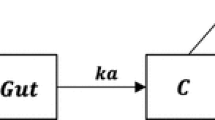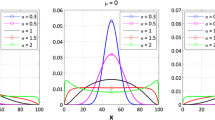Abstract
Any statistical model should be identifiable in order for estimates and tests using it to be meaningful. We consider statistical analysis of physiologically-based pharmacokinetic (PBPK) models in which parameters cannot be estimated precisely from available data, and discuss different types of identifiability that occur in PBPK models and give reasons why they occur. We particularly focus on how the mathematical structure of a PBPK model and lack of appropriate data can lead to statistical models in which it is impossible to estimate at least some parameters precisely. Methods are reviewed which can determine whether a purely linear PBPK model is globally identifiable. We propose a theorem which determines when identifiability at a set of finite and specific values of the mathematical PBPK model (global discete identifiability) implies identifiability of the statistical model. However, we are unable to establish conditions that imply global discrete identifiability, and conclude that the only safe approach to analysis of PBPK models involves Bayesian analysis with truncated priors. Finally, computational issues regarding posterior simulations of PBPK models are discussed. The methodology is very general and can be applied to numerous PBPK models which can be expressed as linear time-invariant systems. A real data set of a PBPK model for exposure to dimethyl arsinic acid (DMA(V)) is presented to illustrate the proposed methodology.




Similar content being viewed by others
References
Zhao P, Zhang L, Grillo JA, Liu Q, Bullock JM, Moon YJ, Song P, Brar SS, Madabushi R, Wu TC, Booth BP, Rahman NA, Reynolds KS, Berglund EG, Lesko LJ, Huang SM (2011) Applications of physiologically based pharmacokinetic (pbpk) modeling and simulation during regulatory review. Clin Pharmacol Ther 89:259–267
Rowland M, Peck C, Tucker G (2011) Physiologically-based pharmacokinetics in drug development and regulatory science. Pharmacol Toxicol 51:45–73
Chiu WA, Barton HA, DeWoskin RS, Schlosser P, Thompson CM, Sonawane B, Lipscomb JC, Krishnan K (2007) Evaluation of physiologically based pharmacokinetic models for use in risk assessment. J Appl Toxicol 27:218–237
Gelman A, Bois F, Jiang J (1996) Physiological pharmacokinetic analysis using population modeling and informative prior distributions. J Am Stat Assoc 91(436):1400–1412
Barton HA, Chiu WA, Setzer RW, Andersen ME, Bailer AJ, Bois FY, DeWoskin RS, Hays S, Johanson G, Jones N, Loizou G, MacPhail RC, Portie CJ, Spendiff M, Tan YM (2007) Characterizing uncertainty and variability in physiologically based pharmacokinetic models: state of the science and needs for research and implementation. Toxicol Sci 99:395–402
van den Hof JM (1998) Structural identifiability of linear compartment systems. IEEE Trans Automat Contr 43(6):800–818
Grewel MS, Glover K (1976) Identifiability of linear and nonlinear dynamic sytems. IEEE Trans Automat Contr 21(6):833–837
Chu Y, Hahn J (2010) Quantitative optimal experimental design using global sensitivity analysis via quasi-linearization. Ind Eng Chem Res 49:7782–7794
Slob W, Janssen PHM, van den Hof JM (1997) Structural identifiability of pbpk models: practical consequences for modeling strategies and study designs. Crit Rev Toxicol 27(3):261–272
Yates JWT (2006) Structural identifiability of physiologically based pharmacokinetic models. J Pharmacokinet Pharmacodyn 33(4):421–439
Cobelli C, DiStefano JJ (1980) Parameter and structural identifiability concepts and ambiguitites: a critical review and analysis. Am J Physiol 239:R7–R24
Thowsen A (1978) Identifiability of dynamic systems. Int J Syst Sci 9(7):813–825
Rothenburg TJ (1971) Identification in parametric models. Econometrica 39(3):577–591
Nunez OG, Concordet D (2007) When is a nonlinear mixed-effects model identifiable? http://halweb.uc3m.es/esp/Personal/personas/nunez/esp/paper/ident_U.pdf
Gelfand AE, Sahu SK (1999) Identifiability, improper priors, and gibbs sampling for generalized linear models. J Am Stat Assoc 94:247–253
Kenyon EM, Hughes MF (2001) A concise review of the toxicity and carcinogenicity of dimethylarsinic acid. Toxicology 160:227–236
Evans MV, Dowd SM, Kenyon EM, Hughes MF, El-Masri HA (2008) A physiologically based pharmacokinetic model for intravenous and ingested dimethylarsinic acid in mice. Toxicol Sci 104(2):250–260
Stevens JT, Hall LL, Farmer JD, DiPasquale LC, Chernoff N, Durham WF (1977) Disposition of 14c and/or 74as-cacodylic acid in rat after intravenous, intratracheal, or peroral administration. Environ Health Perspect 19:151–157
Monagan MB, Geddes KO, Heal KM, Labahn G, Vorkoetter SM, McCarron J, DeMarco P (2005) Maple 10 programming guide. Maplesoft, Waterloo ON
Hughes MF, Kenyon EM (1998) Dose-dependent effects on the disposition of monomethylarsonic acid and dimethylarsinic acid in the mouse after intravenous administration. J Toxicol Environ Health Part A 53(2):95–112
Hughes MF, Del Razo LM, Kenyon EM (2000) Dose-dependent effects on tissue distribution and metabolism of dimethylarsinic acid in the mouse after intravenous administration. Toxicology 143(2):155–166
Hughes MF, Devesa V, Adair BM, Conklin SD, Creed JT, Styblo M, Kenyon EM, Thomas DJ (2008) Tissue dosimetry, metabolism and excretion of pentavalent and trivalent dimethylated arsenic in mice after oral administration. Toxicol Appl Pharmacol 227(1):26–35
Brown RP, Delp MD, Lindstedt SL, Rhomberg LR, Beliles RP (1997) Physiological parameter values for physiologically based pharmacokinetic models. Toxicol Ind Health 13:407–484
Stott WT, Dryzga MD, Ramsey JC (1983) Blood-flow distribution in the mouse. J Appl Toxicol 3:310–312
Geman S, Geman D (1984) Stochastic relaxation, gibbs distributions, and the Bayesian restoration of images. IEEE Trans Pattern Anal Mach Intell 6:721–741
Metropolis N, Rosenbluth AW, Rosenbluth MN, Teller AH, Teller E (1953) Equation of state calculations by fast computing machines. J Chem Phys 21:1087–1092
Hastings WK (1970) Monte carlo sampling methods using markov chains and their applications. Biometrika 57:97–109
Gelman A, Carlin JG, Stern HS, Rubin DB (2003) Bayesian data analysis. Chapman and Hall, Boca Raton
Kass RE, Carlin BP, Gelman A, Neal RM (1998) Markov chain monte carlo in practice: a roundtable discussion. Am Stat 52:93–100
R Development Core Team (2009) R: A language and environment for statistical computing. R Foundation for Statistical Computing, Vienna, Austria. ISBN 3-900051-07-0. http://www.R-project.org/
Plummer M, Best N, Cowles K, Vines K (2010) Coda: output analysis and diagnostics for MCMC. R package version 0.13-5. http://CRAN.R-project.org/package=coda
Best N, Cowles MK, Vines K (1997) Coda: convergence diagnosis and output analysis software for gibbs sampler output: Version 0.4. Technical Report, Medical Research Council Biostatistics Unit, Cambridge
Heidelberger P, Welch PD (1983) Simulation run length control in the presence of an initial transient. Oper Res 31:1109–1144
Geweke J (1992) Evaluating the accuracy of sampling-based approaches to the calculation of posterior moments. In: Bernado J, Berger J, Dawid A, Smith A (eds) Bayesian statistics 4. Oxford University Press, Oxford, pp 169–193
Gelman A, Rubin DB (1992) Inference from iterative simulation using multiple sequences. Stat Sci 7(4):457–472
Spiegelhalter DJ, Best NG, Carlin BP, Linde AVD (2002) Bayesian measures of model complexity and fit. J R Stat Soc Ser B Stat Methodol 64:583–639
Acknowledgments
We thank Marina V. Evans for providing technical review of this work. Three anonymous reviewers’ comments greatly improved the text, for which we thank them. The United States Environmental Protection Agency through its Office of Research and Development funded and managed the research described here. RIG was funded by United States Environmental Protection Agency, National Center for Computational Toxicology through the Curriculum in Toxicology, University of North Carolina under Cooperative Training Program CR83323710.
Author information
Authors and Affiliations
Corresponding author
Additional information
The views expressed in this article are those of the authors and do not necessarily reflect the views or policies of the U.S. Environmental Protection Agency. Mention of trade names or commercial products does not constitute endorsement or recommendation for use.
Appendix
Appendix
Notation used in this appendix is summarized in Tables 3, 4, 5, and 6.
Mathematical representation of PBPK model of DMA
Unknown parameters are D kid , D liv , D lun , D rbc , k a , k b , k r , P kid , P liv , P lun , P rbc .
PBPK models of DMA expressed as a LTIS
Let
represent the amount of DMA in the compartments of mouse i.
The matrix \(\varvec{A}\) is defined as,
where
and,
where we excluded the dependence on i in the elements in \(\varvec{A}_1\), \(\varvec{A}_2\) and \(\varvec{A}_3\).
For mice which were exposed intravenously to DMA
where \(\text{DR}_{IV}\), \(t_0\), and \(\text{C}_{IV,i}\) denote the infusion dosing rate, infusion duration, and infusion DMA exposure concentration of mouse i respectively. For these mice, the total DMA exposure is \(\text{DR}_{IV} \times t_0 \times \text{C}_{IV,i}\). This amount equals the sums of the amounts of DMA in all of the compartments of mouse i, i.e. \(\text{DR}_{IV} \times t_0 \times \text{C}_{IV,i} = {\bf{1}}_{17}' \varvec{g}(t,\varvec{\delta }_i,\varvec{x}_i)\).
For mice which were exposed through oral gavage
where \(\text{F}_{a}\), \(\text{V}_{w,i}\), and \(\text{C}_{w,i}\) denote the fraction of DMA absorbed in the gut, water volume exposure and the oral DMA exposure concentration of mouse i respectively. For these mice, the total DMA exposure is \(\text{F}_{a} \times \text{V}_{w,i} \times \text{C}_{w,i}\). This amount equals the sums of the amounts of DMA in all of the compartments of mouse i, i.e. \(\text{F}_{a} \times \text{V}_{w,i} \times \text{C}_{w,i} = {\bf{1}}_{17}' \varvec{g}(t,\varvec{\delta }_i,\varvec{x}_i)\).
The rows of \(\varvec{C}(\varvec{\delta },\varvec{x})\) are reflected in the columns of Table 6. In this table, \(V_{s} = V_{s.b} + V_{s.t}\) for s = lun, kid, liv. The elements of each column correspond to the weights of the linear combinations of the state variables. Each column corresponds to one of the seven compartments which was measured.
Since the PBPK model of each mouse is different, the models vary due to differences in the values of the PBPK model parameters, covariates, and exposure conditions. In addition, the models differ in structure because of the different types of exposure and measured compartments. The \(\varvec{A}\), \(\varvec{B}\) and \(\varvec{C}\) matrices are different for each mouse. For example, each column of Table 6 would correspond to a row of \(\varvec{C}(\varvec{\delta }_i,\varvec{x}_i)\) if mouse i had that compartment measured. These differences lead to completely different output functions. Thus, two mice which have identical PBPK model parameter values but were exposed differently or had different compartments measured will have completely different output functions.
Recognizable full conditionals of PBPK models of DMA
The full conditional distribution of the parameters \(\varvec{\sigma }^2\), \(\varvec{\eta }\), and \(\varvec{D}\) are
where
The density of the PBPK model parameters of mouse i, \(\varvec{\theta }_i\), is not recognizable but is proportional to,
Rights and permissions
About this article
Cite this article
Garcia, R.I., Ibrahim, J.G., Wambaugh, J.F. et al. Identifiability of PBPK models with applications to dimethylarsinic acid exposure. J Pharmacokinet Pharmacodyn 42, 591–609 (2015). https://doi.org/10.1007/s10928-015-9424-2
Received:
Accepted:
Published:
Issue Date:
DOI: https://doi.org/10.1007/s10928-015-9424-2




